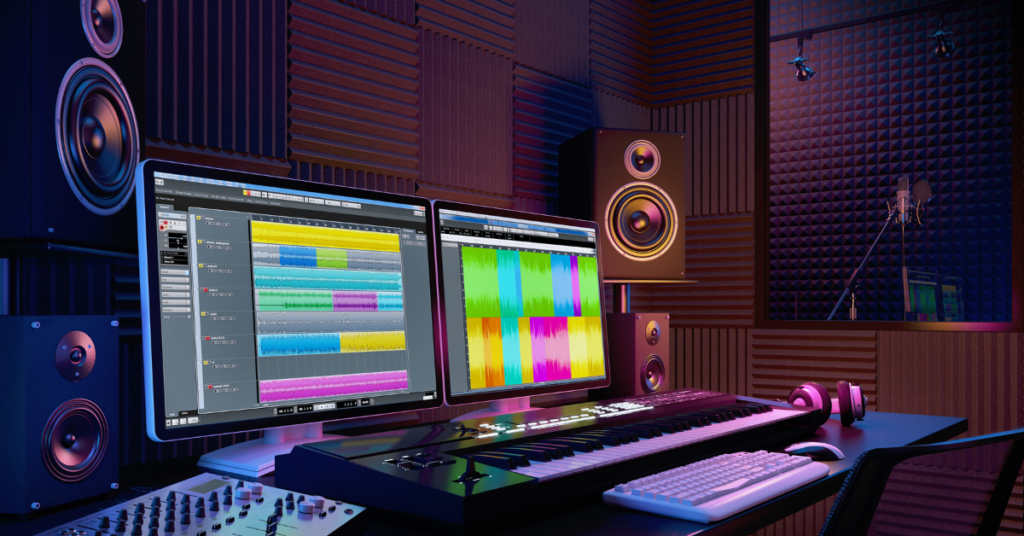Setting up your own home recording studio is one of the most exciting journeys for any musician, producer, or podcaster. The idea of transforming a space into a creative hub, where you can produce music or record vocals with professional sound quality, is empowering and rewarding. But let’s face it—it can be overwhelming. With so many options and products out there, how do you know where to start?
Fear not! In this guide, we’ll walk you through every step of building your home recording studio, from choosing the right equipment to optimizing the space for recording. Whether you’re a beginner or a seasoned pro looking to upgrade, this guide will give you all the insights you need.

Contents
- 1 1. Choosing the Right Space for Your Studio
- 2 2. Acoustic Treatment: The Key to Professional Sound
- 3 3. Must-Have Equipment for Your Home Recording Studio
- 4 4. Setting Up Your Home Recording Studio
- 5 5. Final Thoughts: Evolving Your Home Studio Over Time
1. Choosing the Right Space for Your Studio
Before diving into equipment and software, finding the right room is crucial. You don’t need a huge space, but where you set up your home recording studio can have a massive impact on the quality of your recordings. The goal is to find a space that can be acoustically optimized and has minimal external noise interference.
Room Size and Shape
Bigger isn’t always better. While professional studios often have large rooms, a smaller, well-treated space can offer just as good, if not better, sound quality for home recordings. However, avoid spaces that are too small, as they tend to produce unwanted sound reflections, which could muddy your recordings.
- Ideal room size: A medium-sized room (12′ x 18′ or larger) is a good starting point. It gives you enough space to work with, while also being manageable in terms of acoustic treatment.
- Room shape: Rectangular rooms are preferred over square rooms. Square rooms are more prone to sound wave buildup, creating “standing waves” that can distort recordings. Rectangular spaces, on the other hand, allow sound to distribute more evenly.
Noise Isolation
Your recording space needs to be as quiet as possible to avoid picking up unwanted noise. Here are a few tips to improve noise isolation:
- Choose a room away from noisy areas: Avoid setting up near the kitchen, laundry room, or a busy street.
- Seal doors and windows: Use weatherstrips or foam seals to minimize sound leakage.
- Carpets and curtains: Adding rugs and heavy curtains can reduce external noise.
2. Acoustic Treatment: The Key to Professional Sound
Now that you’ve chosen your space, the next crucial step is acoustic treatment. This is often overlooked by beginners but is arguably one of the most important steps in setting up a home recording studio. Without proper acoustic treatment, even the best equipment will struggle to deliver a professional sound.
Understanding the Basics
Acoustic treatment involves controlling how sound behaves inside your room. The goal is to minimize unwanted sound reflections, absorb excess frequencies, and keep your recordings as clean and clear as possible. There are three main types of acoustic treatments:
Bass Traps
The purpose of bass traps is to absorb low frequencies, also known as the bass tones. Low-end frequencies tend to build up in corners, causing an imbalance in your recordings. Placing bass traps in the corners of your room will significantly reduce this.
- Placement: Bass traps should always be placed in the corners, both vertically and horizontally. Floor-to-ceiling bass traps are the most effective.
- Materials: Look for bass traps made from thick foam or fiberglass for maximum absorption.
Acoustic Panels
Acoustic panels absorb mid and high frequencies, preventing unwanted echoes and reflections. These are essential for creating a “dry” recording space, which is easier to work with in post-production.
- Placement: The best locations for acoustic panels are “first reflection points,” or the places where sound first reflects off a wall. These points are typically located on the sides of your mixing desk, behind your monitors, and sometimes on the ceiling.
- DIY option: If you’re on a budget, you can make DIY panels using materials like rock wool or Owens Corning insulation covered with fabric.
Diffusers
Unlike absorbers, diffusers scatter sound waves rather than absorbing them. They help break up sound reflections in a controlled manner, keeping the room lively without the boxy or “dead” sound caused by too much absorption.
- Placement: Typically, you place diffusers on the ceiling or the rear wall behind your mixing position to scatter mid and high frequencies.
- Materials: Wooden or foam diffusers are popular. You can even build your own if you’re handy with tools.
Why You Should Invest in Acoustic Treatment First
Many people spend thousands on microphones, audio interfaces, and monitors but neglect acoustic treatment. However, proper room treatment can improve your sound drastically, even with budget equipment. It’s the secret sauce that separates amateur recordings from professional-quality ones.
3. Must-Have Equipment for Your Home Recording Studio
Once you’ve treated your space acoustically, it’s time to fill it with gear. A home recording studio doesn’t need to be packed with expensive equipment, especially when you’re just starting. However, there are a few essential pieces you’ll need.
3.1 Audio Interface: Your Connection to the Digital World
An audio interface is the heart of your studio. It converts analog signals from your microphone or instruments into digital signals that your computer can process.
Key Features to Look For:
- Number of Inputs: Consider how many instruments or microphones you’ll need to record simultaneously. For singer-songwriters, a 2-channel interface like the Focusrite Scarlett 2i2 will suffice. If you’re recording drums or a band, you might need an interface with more inputs, like the PreSonus Studio 68c.
- Preamps: High-quality preamps in an audio interface ensure that your recordings are clear and free from unwanted noise. Look for interfaces that offer at least 24-bit/96kHz resolution.
- Latency: Low-latency interfaces ensure that there’s no noticeable delay between when you play and when you hear the sound back through your headphones or monitors. For example, interfaces with Thunderbolt or USB-C connectivity offer faster performance compared to USB 2.0 models.
Popular audio interfaces include:
- Focusrite Scarlett 2i2: Great for beginners and small setups.
- Universal Audio Apollo Twin: Offers high-quality preamps and onboard processing.
- PreSonus AudioBox USB 96: A more affordable option for those starting out.
3.2 Microphones: The Voice of Your Studio
Microphones are one of the most important pieces of equipment in any studio, and different types of mics are better suited for different tasks.
Condenser Microphones
Condenser microphones are highly sensitive and are ideal for capturing detailed vocals and acoustic instruments. They’re the go-to choice for recording vocals, acoustic guitar, piano, and other detailed sources.
- Audio-Technica AT2020: A great entry-level condenser microphone that offers excellent sound quality for its price.
- Rode NT1-A: Known for its ultra-low self-noise, making it perfect for clean vocal recordings.
Dynamic Microphones
Dynamic microphones are less sensitive than condensers, making them ideal for loud sound sources like guitar amps or drums. They’re also more durable and can handle high sound pressure levels.
- Shure SM7B: Famous for its versatility, it’s used in both vocal recording and podcasting. Its built-in pop filter and excellent rejection of background noise make it a favorite for home studios.
3.3 Studio Monitors and Headphones: Accurate Listening
To accurately hear what you’re recording and mixing, you’ll need a decent pair of studio monitors and headphones. These tools allow you to make precise adjustments to your tracks and ensure they’ll sound acceptable on all playback systems.
Studio Monitors
Studio monitors are different from regular speakers in that they are designed to provide a flat-frequency response. This helps you hear the music as it is, without any coloration.
- Yamaha HS5: These monitors are known for their flat response, making them a favorite among many producers.
- KRK Rokit 5: Another popular choice, these monitors offer great sound quality at an affordable price.
Headphones
A good pair of studio headphones will allow you to monitor your recordings and mixes without disturbing others, and they are especially useful in untreated rooms where monitors might not give you the most accurate representation of sound.
- Audio-Technica ATH-M50x: These closed-back headphones are ideal for recording and mixing, offering great isolation and a balanced sound.
3.4 DAW: Your Music Creation Hub
Your Digital Audio Workstation (DAW) is the software you’ll use to record, edit, and produce your music. There are many DAWs available, each with its own strengths and unique features.
Popular DAW Options:
- Ableton Live: Great for electronic music producers and live performances.
- Pro Tools: The industry standard for professional studios.
- Logic Pro X: A favorite among Mac users, offering powerful tools at a reasonable price.
- FL Studio: Known for its user-friendly interface and powerful MIDI features.
4. Setting Up Your Home Recording Studio
With your gear in place, it’s time to create an ergonomic, functional recording setup.
4.1 Desk Setup and Ergonomics
Arrange your desk so that all your essential tools are within easy reach. Place your audio interface and MIDI controller nearby and your studio monitors at ear level, with the tweeters aimed at your ears. This setup ensures that you are hearing the sound as accurately as possible. Also, consider getting a desk designed for studio work, such as one with built-in racks for your gear. Here’s how to optimize your workspace:
- Monitor positioning: Your studio monitors should form an equilateral triangle with your head. This ensures you’re in the “sweet spot” for mixing.
- Height and distance: Keep your monitors at ear level and at least 2-3 feet away from the walls to avoid sound reflections. Use monitor stands if necessary.
- Chair choice: A comfortable, adjustable chair with lumbar support can make long recording and mixing sessions more manageable. Remember, ergonomics is important not only for productivity but also for preventing strain on your body.
4.2 Cable Management
A messy cable situation can cause problems with your workflow and may even result in damage to your equipment over time. Keep cables neat with velcro straps, cable trays, or adhesive hooks to maintain a clutter-free environment.
5. Final Thoughts: Evolving Your Home Studio Over Time
Your first home recording studio doesn’t have to be perfect, and you don’t need to buy everything all at once. Start with the essentials—audio interface, microphone, studio monitors, and DAW—and upgrade as your skills and needs evolve.
Over time, you’ll get a feel for what additional equipment or software will help enhance your recordings, such as a MIDI keyboard, drum machine, or external hardware like compressors and preamps. Your studio should grow with you and your music.
Most importantly, focus on the art of recording and producing. Even with the best gear, your studio won’t be worth much if you don’t practice and experiment. Keep learning, keep tweaking, and most importantly—keep creating.













![The 6 Best Digital Audio Workstations (DAWs) for Your Home Studio [2024] 4 Best DAWs](https://musicfevr.com/wp-content/uploads/2024/10/Best-DAWs.jpg)
